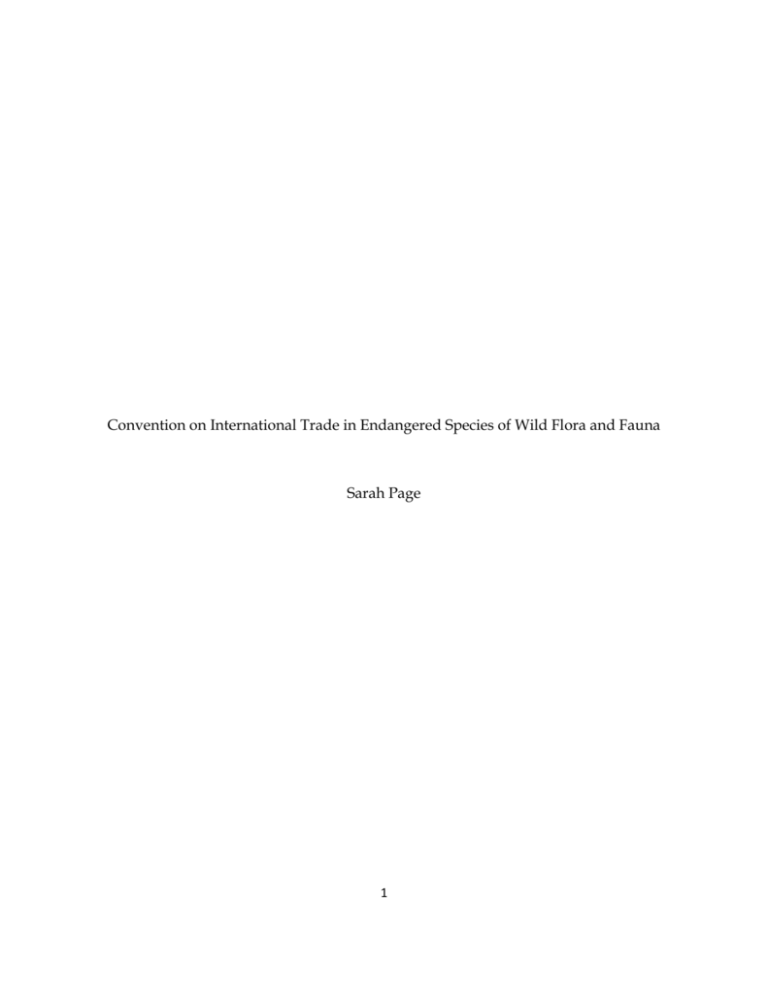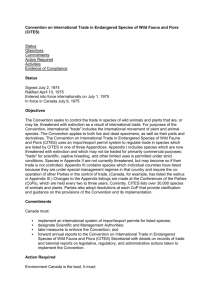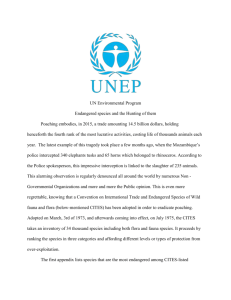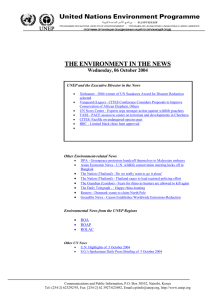File - Sarah MACEY PAGE
advertisement

Convention on International Trade in Endangered Species of Wild Flora and Fauna Sarah Page 1 The Convention on International Trade in Endangered Species of Wild Flora and Fauna often referred to as CITES is the largest wildlife trade treaty to date. The purpose of this treaty is to “ensure that no species of wild fauna or flora becomes or remains subject to unsustainable exploitation because of international trade” (WWF). CITES was drafted as a result of a resolution adopted in 1963 at a meeting with International Union for Conservation of Nature (IUCN) members. The text of the Convention was finally agreed upon at a meeting of representatives of 80 countries in Washington DC in 1973. In 1975, the treaty was in full force. CITES is an international agreement to which States, also known as countries, adhere voluntarily. Although CITES is a legally binding set of laws it does not take place of the national laws. Rather it “provides a framework to be respected by each Party, which has to adopt its own domestic legislation to ensure that CITES is implemented at the national level” (CITES-6). Currently, it has 175 different countries that are in agreement. The nations meet once every two-and-a-half years to consider whether or not they need to add new species, adjust trade rules or to remove species that are no longer threatened (CITES-6). The document itself works by differentiating the species and specimen into a certain Appendix. A specimen is defined as an individual animal, any part of an animal, a plant, or any part of a plant. This includes leathers, ivory, furs, dried herbs and the like. There are three different Appendices and each has different levels of protection from over-exploitation due to trade. Permits are required for either import, export or a 2 certificate for re-export. Species that are listed under Appendix-I are the most endangered. Amongst many other species some of the more commonly known Appendix-I animals include the Hippopotamus, Ocelot and the Polar Bear. They are threatened with extinction and CITES prohibits international trade in specimens of these species. Appendix-II lists species that are not currently threatened with extinction but may become so unless trade of the species is closely monitored. Examples of Appendix-II species include the Barbary sheep, the Wood Bison and Guanaco. Species may be added to or removed from Appendix I and II, or moved between them, only if both parties agree. If agreed they can make the changes at the next meeting or through postal procedures. Appendix-III includes species that are being regulated by one country and wish to have cooperation from other countries to avoid their exploitation i.e. the Black Buck in Nepal. In order to trade a species that is listed in Appendix-III the appropriate permit or certificate must be presented. Species may be added to or removed from Appendix III at any time and by any Party without the other party’s agreement. A species can be listed in both Appendix-I and in Appendix-II if the species is more threatened in a certain location i.e. the African Elephant (CITES-1)(CITES-3). Each Appendix has certain regulations that must be met in order to transport a specimen. They all require that the specimen is legally obtained, that the specimen will not be detrimental to the survival of the species and that in the case of a live animal or plant it will be shipped in a way that will not risk injury, death or cruel treatment. 3 Appendix-I requires an import permit issued by the Management Authority of the State of Import. Also requiring an export permit or re-export certificate from the Management Authority of the State of Export. Appendix I states that in the case of a live animal or plant the country exporting must be satisfied that the proposed recipient is equipped to care for it. The difference between Appendix I and Appendix II being that Appendix II does not require an import permit in order to export the specimen unless required by national law. Of course there are exceptions to rules and the treaty is not immune to these exceptions. For example, there are different regulations for specimens that were acquired prior to the convention, specimens that are being shipped, animals that were ‘bred in captivity’ and plants that have been ‘artificially propagated’ (CITES1). CITES is made up of departments who all have specialized staff who carry out different tasks. This includes the leaders who sign the treaty to those within the country who enforce the treaty. The structure of the Treaty begins with a Conference of Parties. The meeting of parties usually last for approximately two weeks and is hosted by one of the countries. The Conference has several tasks that need to be discussed. Amongst them is reviewing the progress for species that are listed, considering any changes, making measures to improve the effectiveness of conservation and provisions that allow the Secretariat the room to function effectively. The Secretariat is administered by the IUCN and is the basic coordinator for all the parties involved. It arranges all the 4 meetings, helps with enforcement issues, makes recommendations regarding implementation and issues annual reports with updates to the species that are listed. There are two committees that provide scientific information to the Secretariat. One has specialties in the flora department while the other specializes in fauna. With the knowledge about the species listed the information is passed on to enforcement organizations such as TRAFFIC, IUCN and the UNEP-WCMC (CITES-5). TRAFFIC is a wildlife trade network that monitors the trade of species that are threatened or endangered. This organization employs approximately 100 people in 30 different countries and also works very closely with WWF and the IUCN (TRAFFIC). This treaty could be classified as an Institutional model because the Parties or Countries involved make the decisions about the species that are listed. However, the group model can apply at the very basic level of getting people together and writing their local government to discuss a certain species’ survival. If the group has enough evidence to prove that the species needs to be conserved the Country can then make a proposal to the Secretariat. With the Endangered Species Act in the United States it is easier to make a proposal because gathering the scientific information in other countries is still an ongoing battle (WWF). However, recently the Secretariat received as many as 50 proposals for different species all in different countries (CITES-4). The CITES treaty not only employs people from many countries but it also affects those who live in the country that is in accordance with it. An article by E.H. Bulte, G. 5 Kooten and T. Swanson, which can be found on the CITES website, discusses the economic incentives for protecting wildlife. The authors say that the one of the main dilemmas is the costs and benefits of protecting wildlife are different for “source” countries. For example, the African Elephant who is valued by those who will someday see them in the wild (including those who value that they even exist) is far different than the country that contains them. While the cost of tourism is a very large part of their Gross National Profit the cost of highly prized ivory is worth far more to someone who lives in the area (CITES-2). In order for wildlife treaties or protection laws to become fully effective there needs to be a more effective cost benefit analysis for those who live in the source countries. While CITES is an effective treaty for many species there is still much improvement that is needed to be made, mainly with the countries that contain the most precious and endangered species. When the inherent value of a species matches the monetary value for those who contain them, only then will there be progress. However, such a day may not come with the current turmoil that exists in the countries that contain the most treasured species. 6 References 1) Convention on International Trade of Endangered Species of Wild Fauna and Flora. http://www.cites.org/eng/disc/how.shtml. How CITES Works. 28 March 2009. 2) Convention on International Trade of Endangered Species of Wild Fauna and Flora. http://www.cites.org/eng/prog/economics/CITES-draft6-final.pdf. Economic Incentives and Wildlife Conservation. 28 March 2009 3) Convention on International Trade of Endangered Species of Wild Fauna and Flora. http://www.cites.org/eng/app/appendices.shtml. The Appendices I, II, III. 28 March 2009 4) Convention on International Trade of Endangered Species of Wild Fauna and Flora. http://www.cites.org/eng/disc/sec/index.shtml. The CITES Secretariat. 28 March 2009. 5) Convention on International Trade of Endangered Species of Wild Fauna and Flora. http://www.cites.org/eng/disc/org.shtml. The Structure of CITES. 28 March 2009 6) Convention on International Trade of Endangered Species of Wild Fauna and Flora. http://www.cites.org/eng/disc/whats.html. What is CITES? 28 March 2009. 7 7) World Wildlife Fund. http://www.worldwildlife.org/what/globalmarkets/wildlifetrade/cites about.html. Wildlife Trade. 26 March 2009. 8) TRAFFIC- The Wildlife Trade Monitoring Network. http://www.traffic.org/overview/. About TRAFFIC. 26 March 2009 8











